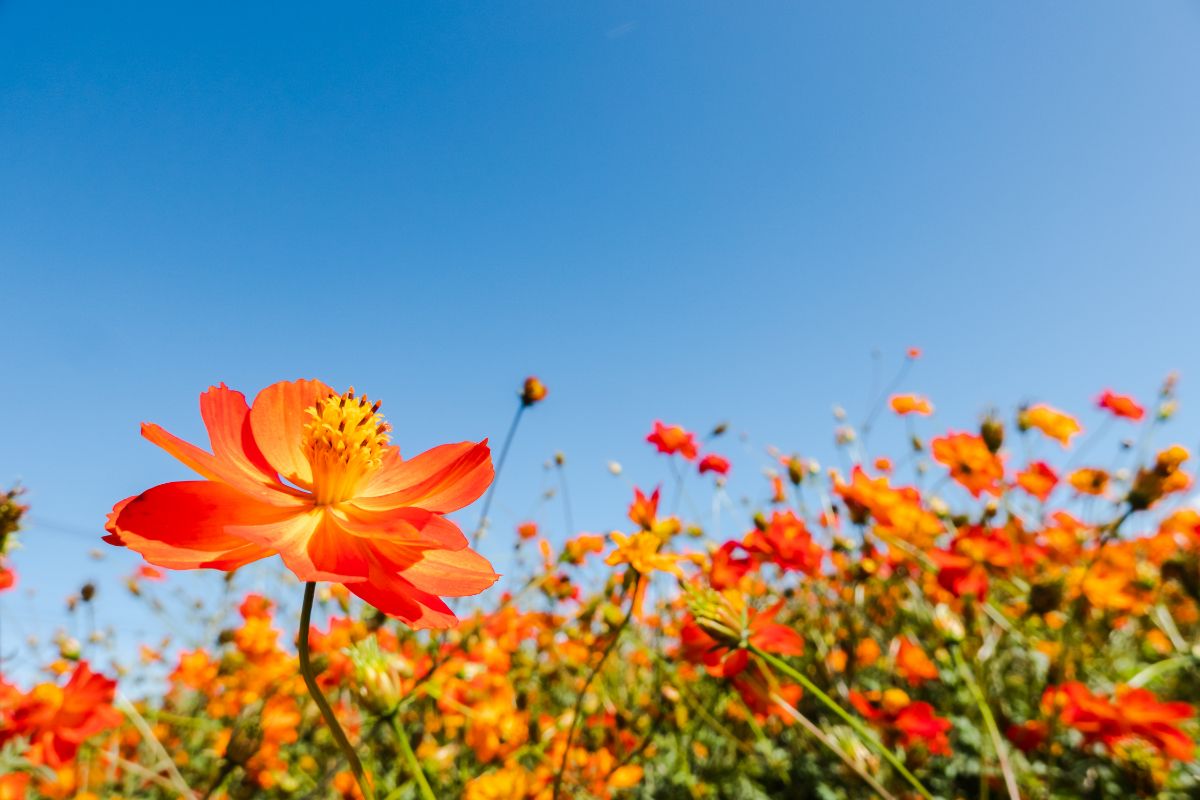Are you looking to add some vibrant blooms to your garden this summer? Cosmos are a popular choice for their colorful petals and easy-to-grow nature.

But, are cosmos perennials, and can you increase their summer bloom time? In this article, we’ll explore the world of cosmos flowers, their life cycle, and tips on how to keep them blooming all season long.
So, whether you’re a seasoned gardener or just starting out, read on to learn how to create a stunning display of cosmos in your garden.
What Are Cosmos?
Cosmos are a genus of flowering plants that belong to the Asteraceae family.
These plants are native to Mexico and other parts of Central and South America, but they are now widely cultivated in many regions of the world.
Cosmos plants are popular among gardeners for their attractive and colorful daisy-like flowers that come in a range of colors such as pink, red, white, and orange.
The plants are also known for their delicate, feathery foliage, which adds texture and interest to any garden.
Cosmos are annual or perennial plants depending on the species, and they can grow to be anywhere from 1 to 6 feet tall.
What Are Perennials?
Perennials are plants that live for more than two years and continue to grow and bloom each year.
Unlike annuals, which complete their life cycle in one growing season and die, perennials can live for several years and come back year after year.
Perennial plants survive the winter months by storing energy in their roots or underground bulbs, and then sprout new growth in the spring.
Some examples of popular perennial flowers include peonies, daisies, daylilies, and black-eyed Susans.
Perennials are popular among gardeners because they provide long-lasting color and interest to a garden, and they require less effort than annuals since they don’t need to be replanted every year.
Are Cosmos Perennials?
Some species of cosmos are perennials, while others are annuals. Cosmos bipinnatus, which is the most common species of cosmos, is an annual plant. This means that it completes its life cycle in one growing season and then dies.
However, there are some perennial species of cosmos such as Cosmos atrosanguineus and Cosmos sulphureus. These species can live for more than two years and continue to bloom year after year.
So, if you are interested in growing cosmos as perennials, make sure to choose the appropriate species and provide them with the right care to help them thrive.
When Is The Best Time To Grow Cosmos?
The best time to grow cosmos depends on your location and the climate. Cosmos are warm-season annuals that prefer warm soil and air temperatures.
In general, it’s best to plant cosmos outdoors after the last frost date in your area, when the soil has warmed up and the risk of frost has passed.
In the United States, the best time to plant cosmos is typically in the spring, after the last frost date, and before the temperatures get too hot. In warmer areas, cosmos can also be planted in the fall for a late-season bloom.
If you plan to start cosmos indoors, you should start the seeds about 4-6 weeks before the last frost date. This will give the plants a head start and help them to bloom earlier in the summer.
Ultimately, the best time to grow cosmos depends on your specific location and climate. Check with your local gardening center or cooperative extension service for specific recommendations on planting times in your area.
How To Grow Cosmos
Here are the steps to grow cosmos:
- Select the correct location: Cosmos plants thrive in full sun and soil that drains well. Choose a place that gets a minimum of 6 hours of sun each day and has soil that is not waterlogged.
- Plant the seeds: Cosmos can be grown from seeds, which are widely available in garden centers and online.
Sow seeds directly in the garden after the last frost date in your area. Rake the soil to create a smooth surface, then sprinkle the seeds across the soil and cover them lightly with a layer of soil.
- Water seeds: Water the cosmos seeds to keep the soil damp, but not waterlogged. Water regularly until your seeds have germinated and the plants are fully established.
- Thin out seedlings: When the seedlings have grown a few inches, thin them so that there is about 18 inches of space between each plant. This will allow the plants to grow and spread out without crowding each other.
How To Increase Summer Bloom Time
If you want to increase the summer bloom time of your cosmos plants, here are some tips you can follow:
- Deadhead regularly: Removing spent blooms regularly will encourage the plant to produce more flowers.
- Fertilize: Provide your cosmos plants with regular fertilization to promote healthy growth and abundant blooms. A balanced fertilizer with equal parts nitrogen, phosphorus, and potassium is ideal.
- Water properly: Cosmos plants prefer well-drained soil that is moist but not soggy. Water them deeply once or twice a week, depending on the weather conditions.
- Provide enough sunlight: Cosmos plants need full sunlight to thrive and produce abundant blooms. Make sure they receive at least 6 hours of direct sunlight per day.
- Mulch: Applying a layer of organic mulch around the base of your cosmos plants can help retain moisture in the soil, keep the roots cool, and reduce weed growth.
By following these simple tips, you can help your cosmos plants bloom for a longer period during the summer months, creating a beautiful and colorful display in your garden.
Other Tips For Growing Cosmos

Here are some additional tips for growing cosmos:
- Choose the right location: Cosmos plants prefer well-drained soil with a pH of 6.0 to 7.0. They also need full sunlight, so choose a location that receives at least 6 hours of direct sunlight per day.
- Plant at the right time: Cosmos can be planted from seed or as young plants. If planting from seed, sow them directly in the garden after the last frost date. If planting as young plants, wait until the soil has warmed up and there is no more risk of frost.
- Provide support: Cosmos can grow tall and leggy, especially if they are not getting enough sunlight. Consider staking or providing other support for your plants to keep them upright.
- Control pests and diseases: Watch out for common pests such as aphids and spider mites, which can damage cosmos plants. To prevent diseases, avoid overhead watering and make sure there is good air circulation around the plants.
- Consider companion planting: Cosmos plants can benefit from companion planting with other flowers and herbs such as marigolds, zinnias, and basil, which can help deter pests and attract pollinators.
If you follow these tips, you can help your cosmos plants thrive and produce beautiful blooms throughout the summer season.
Final Thoughts
Cosmos are a beautiful addition to any garden with their showy, daisy-like flowers and delicate fern-like foliage. While some species of cosmos are perennials, the most common type, Cosmos bipinnatus, is an annual.
However, with the right care, you can encourage your cosmos plants to bloom for a longer period during the summer months.
By deadheading regularly, fertilizing, watering properly, providing enough sunlight, and mulching, you can increase the summer bloom time of your cosmos plants.
Additionally, by following the tips for growing cosmos, such as choosing the right location, planting at the right time, providing support, controlling pests and diseases, and considering companion planting, you can ensure healthy growth and abundant blooms.
With a little effort, you can enjoy the beauty of cosmos in your garden year after year.
- Interesting Flowers That Start With A - July 21, 2023
- Interesting Flowers Beginning With H - July 21, 2023
- 14 Fascinating Flowers That Begin With C - July 20, 2023
